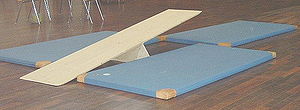


Agilityornimbleness is an ability to change the body's position quickly and requires the integration of isolated movement skills using a combination of balance, coordination, speed, reflexes, strength, and endurance. More specifically, it is dependent on these six skills:
In sports, agility is often defined in terms of an individual sport, due to it being an integration of many components each used differently (specific to all sorts of different sports). Sheppard and Young (2006) defined agility as a "rapid whole body movement with change of direction or velocity in response to a stimulus".[1]
Agility is also an important attribute in many role playing games, both video games such as Pokémon, and tabletop games such as Dungeons & Dragons. Agility may affect the character's ability to evade an enemy's attack or land their own, or pickpocket and pick locks.
In modern-day psychology, author, psychologist, and executive coach Susan David introduces a concept that she terms “emotional agility,” defined as: “being flexible with your thoughts and feelings so that you can respond optimally to everyday situations.”[2][3]
The concept has also been applied to higher education management and leadership, where it was used to accelerate slower traditional and deliberative processes and to replace them with corporate decision-making.[4]